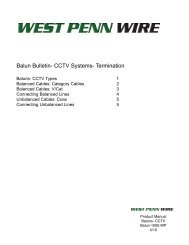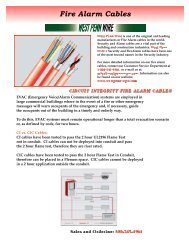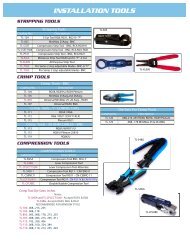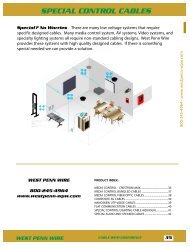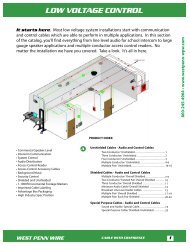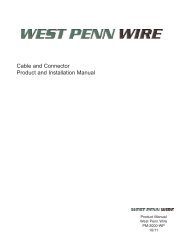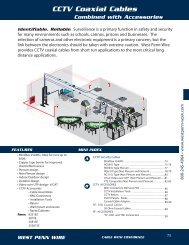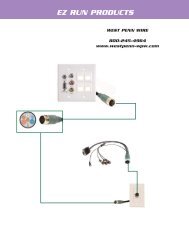You also want an ePaper? Increase the reach of your titles
YUMPU automatically turns print PDFs into web optimized ePapers that Google loves.
Understanding the National Electrical Code<br />
The National Electrical Code (NEC) is a set of guidelines written to<br />
govern the installation of wiring and equipment in commercial<br />
buildings and residential areas. These guidelines were developed<br />
to ensure the safety of humans as well as property against fires<br />
and electrical hazards. Understanding the National Electrical Code<br />
is important from the cable manufacturer engineer and distributor,<br />
to the designer and installer. Anyone involved in specifying cable<br />
to installation of cable should be aware of the basics of the code.<br />
In 1987, the National Electrical Code introduced some major<br />
changes that had a major impact on the wire and cable industry.<br />
The code now has listing requirements for communication and<br />
power-limited circuit cable. These requirements developed fire<br />
resistance levels for cable. The code covers initiation of fire by<br />
electronic cable as well as flame spread characteristics of the cable.<br />
Code Organization<br />
The NEC code book is made up of nine chapters, with each chapter<br />
divided into separate articles pertaining to specific subjects. There<br />
are about five articles that pertain to communication and powerlimited<br />
cable. Each article describes wire and cable construction,<br />
material use, cable markings, installation environments and applications.<br />
Article Categories<br />
There are four articles that cover communication, power-limited<br />
and CATV wiring. There is another category that deals strictly with<br />
optical fiber. The following is a list of those articles and the applications<br />
or systems they cover:<br />
Article 725 - Class 1, Class 2, Class 3, Remote-control, Signaling<br />
and Power-Limited circuits<br />
Article 760 - <strong>Fire</strong> Protective Signaling Systems<br />
Article 770 - Fiber Optic Systems<br />
Article 800 - Communication Circuits<br />
Article 820 - Community Antenna Television<br />
Article Overviews<br />
The NEC code can be somewhat confusing to the novice who has<br />
not studied the code in depth. In most cases, within an article, a<br />
listing will allow for a higher listed cable to be substituted for<br />
lower listed cable. Or some listings from one article may be substituted<br />
for another article listing with possible restrictions. This section<br />
will briefly cover the basis of the code to try to make things<br />
clearer for you. You should consult the NEC book for exact specifications,<br />
wording, and accuracy of the code. This is not in any way<br />
an exact excerpt from the code.<br />
Article 725<br />
Article 725 covers Class 1, Class 2, and Class 3 remote control and<br />
signaling cables as well as power-limited tray cable. Power-limited<br />
tray cable can be used as a Class 3 or Class 2 cable. Cable listed<br />
multi-purpose, communications, or power-limited fire protective<br />
can be used for Class 2 and Class 3 applications. A Class 3 listed<br />
cable can be used as a Class 2 cable.<br />
Article 760<br />
Article 760 covers power-limited fire protective cable. Cable listed<br />
as power-limited fire protective cable can also be used as Class 2<br />
and Class 3 cable. Cable listed as communications and Class 3 can<br />
be used as power-limited fire protective cable with restrictions to<br />
conductor material and type, gauge size and number of conductors.<br />
190<br />
Technical Reference<br />
Article 770<br />
Article 770 covers fiber optic cable. This article covers three general<br />
types: non-conductive, conductive, and composite. Non-conductive<br />
type refers to cable containing no metallic members and no other<br />
electrically conductive materials. Conductive type refers to cable<br />
containing non-current carrying conductive members such as<br />
metallic strength members, etc. Composite type refers to cable containing<br />
optical fibers and current carrying electrical conductors.<br />
Composite types are classified according to the type of electrical<br />
circuit that the metallic conductor is designed for.<br />
Article 800<br />
Article 800 covers multi-purpose and communication cable. Multipurpose<br />
cable is the highest listing for a cable and can be used for<br />
communication, Class 2, Class 3, and power-limited fire protective<br />
cable. Communication cable can be used for Class 2 and Class 3<br />
cable and also as a power-limited fire protective cable with restrictions.<br />
Article 820<br />
Article 820 covers community antenna television and RF cable.<br />
CATV cable may be substituted with multi-purpose or communication<br />
listed coaxial cable.<br />
Designation and Environmental Areas<br />
Not only does listing by circuit types have to be adhered to, but<br />
installation in various environments have to also be considered.<br />
The NEC has designated four categories for various environments.<br />
These will be listed from the highest to the lowest listing. A higher<br />
listing can be used as a substitute for a lower listing.<br />
Plenum - This listing is suitable for use in ducts, plenums, and<br />
other space used for environmental air without conduit and has<br />
adequate fire-resistant and low-smoke producing characteristics. It<br />
can also be used for applications below.<br />
Riser - This listing is suitable for use in a vertical run, in a shaft or<br />
from floor to floor, and has fire-resistant characteristics capable of<br />
preventing the carrying of fire from floor to floor. It can also be<br />
used for applications below.<br />
General Purpose - This listing is suitable for general-purpose use,<br />
with the exception of risers, ducts, plenums, and other space used<br />
for environmental air, and is resistant to the spread of fire. It can<br />
also be used for all applications below.<br />
Restricted Applications - This listing is for limited use and is suitable<br />
for use in dwellings and for use in raceways and is flame<br />
retardant. Restricted use is limited to non-concealed spaces of 10<br />
feet or less, fully enclosed in conduit or raceway, or cable with<br />
diameters less than .25" for a residential dwelling.



